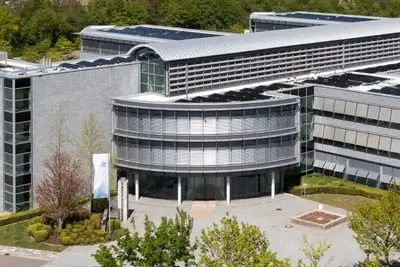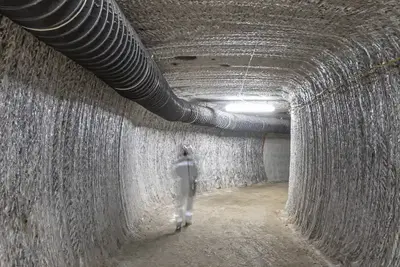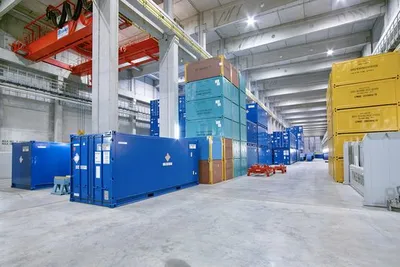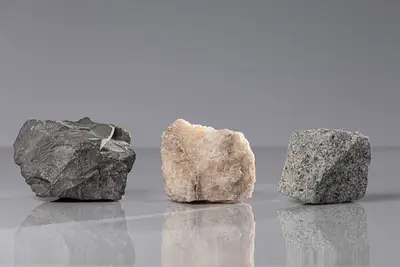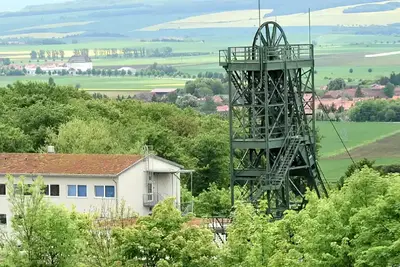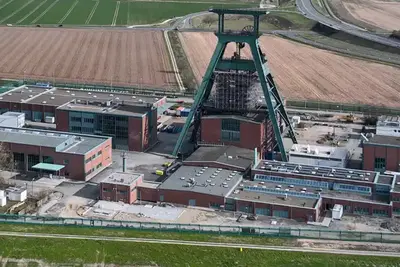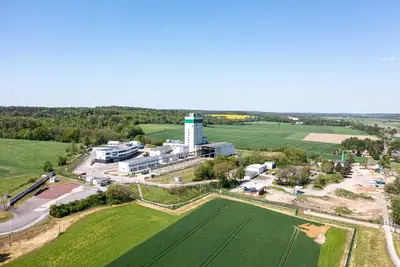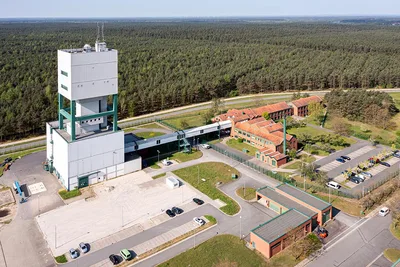Questions and answers regarding the Konrad repository and the evaluation
What is the Konrad repository?
Since April 2017, the Bundesgesellschaft für Endlagerung (BGE) has been responsible for the construction, operation and closure of the Konrad repository in Salzgitter, Lower Saxony. The repository is intended for low- and intermediate-level radioactive waste. This waste arises primarily from the operation and dismantling of nuclear power plants as well as from research institutions, industry and medicine.
In 2002, the Konrad mine became the first repository to be licensed under German nuclear law. The planning approval was confirmed by the Federal Administrative Court in 2007, since then it has been legally binding. The former iron-ore mine is currently being converted and expanded into a repository and will then be used for the final disposal of up to 303,000 cubic metres of radioactive waste with negligible heat generation – that is, low- and intermediate-level radioactive waste.
The Konrad repository is due to be completed in 2027. The predicted costs for the emplacement chambers constructed at a depth of approximately 1,000 metres as well as the entire technical infrastructure for the safe handling of radioactive waste packages run to around €4.2 billion. These are the costs for construction only. The operating costs have not yet been included.
What is the evaluation of safety requirements?
The evaluation of compliance with the safety requirements for the Konrad repository in light of the state of the art of science and technology is the first of its kind. As a responsible operator, the BGE is continuing the voluntary evaluation process initiated by the previous operator, the Federal Office for Radiation Protection (BfS). Issued by the state of Lower Saxony on 22 May 2002, the planning approval was based on the state of the art of science and technology at the time.
The evaluation is now intended to determine, in several phases, whether there are any discrepancies relevant for safety between the state of the art of science and technology at the time and that of the present day. In the first phase, the need for an evaluation was determined. In other words, this phase examined whether changes in the state of the art of science and technology have had an impact on safety analyses of the Konrad repository. A subsequent Phase 2 of the evaluation will examine in greater detail only those areas in which a need for an evaluation was identified in Phase 1, and the relevant safety analysis will be updated.
What is the current status of the evaluation?
In the first phase of the evaluation, four topic areas were addressed by six research institutes and engineering firms. The contractors were acquired within the framework of a public call for tenders, which imposed specific requirements in terms of the applicants’ technical expertise. The topic areas were: safety analysis of normal operation (Brenk Systemplanung GmbH), accident analysis (DMT GmbH & Co. KG, DSR Ingenieurgesellschaft mbH), safety analysis in relation to ensuring subcriticality in the operational phase (TÜV Rheinland Industrie Service GmbH) and safety analysis of the post-operational phase (Gesellschaft für Anlagen und Reaktorsicherheit GRS gGmbH, AF.Consult Switzerland Ltd., DMT GmbH & Co. KG). After drafts of the reports were submitted, the BGE commissioned a team of four scientists to carry out a peer review.
The peer review team, which was characterised by its technical expertise and independence, consisted of: Professor Klaus-Jürgen Röhlig (Institute of Disposal Research, TU Clausthal), Christian Küppers (Nuclear Engineering and Facility Safety, Öko-Institut e.V., Darmstadt), Professor Thorsten Schäfer (Institute of Geosciences/Applied Geology, Friedrich Schiller University, Jena) and Professor Clemens Walther (Institute of Radioecology and Radiation Protection, Leibniz University Hannover). This preliminary state of affairs was presented to the specialist community in Braunschweig on 23 January 2019 before a further revision took place. The final reports from Phase 1 are now available.
What are the next steps in the evaluation?
Based on the final reports submitted by the contractors and the peer review team, the BGE is now preparing for Phase 2 of the evaluation. In Phase 2, the safety analyses will be examined in greater depth and updated if necessary. The BGE will take account of all safety-relevant areas in need of an evaluation that were identified in Phase 1 in addition to the information provided by the contractors and peer review team. Tasks identified in the process will be arranged into topics and dealt with systematically and with the necessary care with the help of external and internal experts. The preparation and carrying out of Phase 2 will take an extended period of time. The plan is also to discuss the results of Phase 2 with the specialist community at a workshop. In addition, the results will be subject to independent peer review, as in Phase 1.
What does the “post-operational phase” mean?
This is the period of time after the radioactive waste has been placed underground in the Konrad repository, the emplacement chambers have been backfilled with special concrete, further cavities have been backfilled, and the two shafts of the repository have been securely sealed.
The aim of final disposal is to permanently enclose the radioactive waste in deep geological formations. In order to demonstrate that this objective will be achieved, geoscientific methods were used to predict the long-term development of the Konrad repository as part of the licensing procedure. Model calculations were performed in order to examine and assess the spread of radionuclides from the repository into the near-surface groundwater.
The results showed that the proof of safety required by the Atomic Energy Act has been provided successfully and that all dose values will be adhered to on a lasting basis. In the Konrad repository, long-term safety is ensured by the specific geological conditions and the secure sealing of both shafts.
Why is the Konrad repository being built in a former extraction mine?
All emplacement chambers, as well as the majority of the underground infrastructure spaces, are being newly excavated in previously unmined sections of the deposit – that is, the sections that were not used for raw-material extraction. No former mine excavations will be used for the final disposal of radioactive waste. Only the existing shafts and some underground infrastructure roads will continue to be used following conversion to repository operation.
Why is the Konrad repository being built without retrievability?
For the Konrad repository, the concept of non-retrievable storage offers maximum safety for the workers and the environment. Retrievability would be “associated with greater environmental impact, as operational discharges from the emplacement areas are still to be expected in the long term and either these discharges will not take place if the waste is backfilled and the emplacement chambers are sealed off or they will be significantly reduced until the repository is sealed off from the biosphere”, as stated by the licensing authority – the Lower Saxony Ministry for the Environment – in the planning approval (section C I - 14) in 2002. “Retrievable storage also requires additional work and control measures, which are associated with additional radiation exposure for personnel.”
In 2010, the Federal Ministry for the Environment (BMUV) published the “Safety requirements for the final disposal of heat-generating radioactive waste”. In relation to retrievability, these requirements clearly state that, in the event of simultaneous emplacement of waste with negligible heat generation, i.e. the type of waste that is to be emplaced in the Konrad repository, the retrievability requirements are not to be complied with for this waste.
For the Konrad repository, the concept of non-retrievable storage offers maximum safety for the workers and the environment. Retrievability would be “associated with greater environmental impact, as operational discharges from the emplacement areas are still to be expected in the long term and either these discharges will not take place if the waste is backfilled and the emplacement chambers are sealed off or they will be significantly reduced until the repository is sealed off from the biosphere”, as stated by the licensing authority – the Lower Saxony Ministry for the Environment – in the planning approval (section C I - 14) in 2002. “Retrievable storage also requires additional work and control measures, which are associated with additional radiation exposure for personnel.”
What about transports to the Konrad repository?
In 2009, the Gesellschaft für Anlagen- und Reaktorsicherheit mbH (GRS) carried out the Konrad Transport Study on behalf of the federal government. In 2012, the consultancy firm intac GmbH carried out a technical assessment of the Konrad Transport Study on behalf of the City of Salzgitter. In turn, GRS issued a statement in relation to the assessment. As part of its reassessment (Konrad Transport Study, 2009), GRS showed that the waste transports coming together in the siting region of the Konrad repository do not represent a significant radiological risk to the population, the transport personnel or the environment.
This applies both to normal transport and to transport accidents. On 14 July 2015, the BfS brought together all participating actors within the framework of the “Konrad Transport Study” specialist workshop, which aimed to identify areas of technical consensus and disagreement, to determine competences for the individual topic areas, and to discuss the further procedure.
With regard to the question from the City of Braunschweig as to when an update of the Konrad Transport Study can be expected, the BMU made the following statement: “In order to be able to take account of the inventory of waste packages as realistically as possible and therefore, in particular, to be able to make specific estimates of the inventory in comparison with earlier studies, an updated Konrad Transport Study should be conducted as close as possible to the time of the repository’s commissioning.”
Why is a logistics centre being planned for the Konrad repository?
The planning approval for the Konrad repository provides for continual delivery of waste with negligible heat generation, which is to be placed in final disposal underground following the necessary receiving inspections and without further interim storage. Furthermore, the planning approval contains a series of important and detailed requirements in relation to the types of waste and packages that can be emplaced together and in what numbers. A logistics centre would make the delivery of waste packages faster and more straightforward. Although it is not a necessary condition for the operation of the Konrad repository, the logistics centre will allow efficient two-shift operation, which is the aim when it comes to emplacement.

